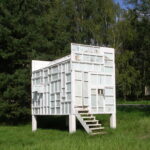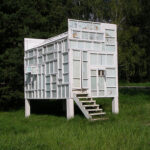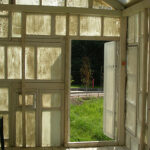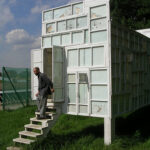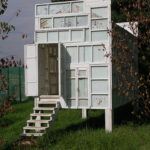Rob Walker and Joshua Glenn’s Significant Objects project teams up writers with junk finds and then auctions a short story with the inspiring object on E-Bay. The idea, I believe, is to reinvest meaning into the detritus of daily life. But, really, do you need any complicated theorizing to convince you to buy a totally awesome Jerry Lundegaard JFK bust that comes with its own backstory? Of course not. For what it’s worth, Glenn was coauthor, with Carol Hayes, of Taking Things Seriously. You should buy that too, while you’ve got your e-wallet out. Unfortunately, Ben’s mug is already gone. Damn.
Month: July 2009
Design Your Life
A (very) brief time out from my own self-promotion to celebrate the publication of the latest tome in Ellen Lupton’s continuing project to better our life quality through design. Written in collaboration with her twin sister, Julia, Design Your Life is a joyful, thoughtful, rumination on the objects that occupy us, how we might tailor them, and how to get the most out of them. Beyond the writing and the design, Ellen has also illustrated the book with her lovely paintings. (No, there’s nothing she can’t do, though she did leave the cover to Chip Kidd—if you can’t design it yourself, hire the best.) I learned a good deal of what I know about design from Ellen, and was privileged (truly, the word is used too freely) to work with her on a series of wonderful books for Princeton Architectural Press. Over the last few years she’s taken some flack from professional designers and guardians of the ivory tower for her prosteltyzing zeal, the argument being that in opening up the field she has diminished the standing of those who do design for a living. These are designers who imagine themselves as members of some kind of formal society that should practically be licensed—like surgeons or lawyers or plumbers. But I think designers are more like writers. And teaching literacy isn’t going to reduce the desire for the Updikes and Lethems and Hemons of the world—it will only increase it. Same story in design. The wider the population conversant in the language of design, the better for designers, and (more importantly) the better for everyone else. So all hail Ellen, design’s educator-in-chief. Now go buy the book.
The Folly of Man
“All the evidence of history suggests that man is indeed a rational animal but with a near infinite capacity for folly. His history seems largely a halting, but persistent, effort to raise his reason above his animality. He draws blueprints for utopia, but never quite gets it built. In the end he plugs away obstinately with the only building material really ever at hand: his own part-comic, part-tragic, part-cussed, but part-glorious nature.”—Robert McNamara
But isn’t the drawing of utopian blueprints also the least rational and most foolish thing we do, the excuse for us to unleash our animality?
Architecture for Sale (Wright vs. Johnson)
On the left, Frank Lloyd Wright’s Ennis House (1924) in the Hollywood Hills, on the market for $15 million. On the right, Philip Johnson’s Farney House (1946) in Sagaponack, on the market for $35 million. The Ennis is one of the glories of Wright’s textile block period. The Farney, which has been expanded considerably, was in its original form an elegant beach house perched on the Hamptons dunes. One doesn’t generally associate Johnson with modesty, and the $35 million pricetag certainly isn’t, but this was a simple structure, really just a pair of cedar-sided wings connected via a living room and an open breezeway. Wright and Johnson had a stormy relationship marked by mutual necessity, professional jealousy, and a sense of admiration that was largely uni-directional. Wright is justly more celebrated. Johnson, however, had his moments. Given the choice (and the extra $20 million) I’d rather live in the Farney. Of course, I’m a New Yorker.
Nazdorovye!
Barack Obama is in Moscow hitting the reset button on Russian-American relations. We applaud the effort, and suggest there would be no better place for him to toast this new direction with misters Medvedev and Putin than Sasha Brodsky’s Vodka Drinking Pavilion, just outside the city. It’s built entirely of repurposed windows from a demolished 19th century factory building. A few more pictures below, with the architect himself. One of the most beautiful spaces in the world.
Antwerp Central
There are several beautiful passages in the opening pages of W.G. Sebald’s novel Austerlitz devoted to the idiosyncratic architecture of Antwerp’s central rail station. Built at the turn of the twentieth century, it’s a resplendent mash of neo-baroque forms and oriental detail. Standing beneath the soaring dome (modeled on Roman Pantheon) of its main ticketing hall, one might naturally think of Jacob Burckhardt’s assertion that, “the character of whole nations, cultures, and epochs speaks through the totality of their architecture, which is the outward shell of their being.” Certainly that great room speaks to the overwhelming imperial impulse of its patron, Belgium’s King Leopold II. Part of the curiosity of the place is its many authors. The main building was designed by the architect Louis Delacenserie while the immense steel-and-glass shed to which it is attached was engineered by Clement van Bogaert, and the battered rampart on which many trains enter the station (and which rings the eastern edge of the city) is the work of Jan Van Asperen. Their work alone makes the station an architectural glory, but a recent overhaul by the Belgian rail facility specialist Eurostation only makes it more spectacular. Trains now enter and exit the station on multiple levels, and a trench cut through the center gives dramatic views of the cars moving in and out. The high-tech modern aesthetic is seamlessly integrated with the older forms of the shed and original hall, making circulation a breeze. It is the apogee of public transportation.
Ovid: On Picking Up Girls (Literally)
And if she doesn’t give [kisses] freely, just take them anyway, ungiven. Maybe at first she’ll fight, and call you “wicked rogue”; but her wish in fighting is really to be won. Only be sure your clumsy force doesn’t bruise her tender lips or that she can complain of roughness. A man who has taken kisses and nothing more deserves to lose even what was already granted. After a kiss any failure in the fulfillment of desire—well, really, that’s not modesty, it’s just bad manners! Invoke violence if you like; this is a violence girls appreciate. The thing that they enjoy, they often like to think they give unwillingly. A woman suddenly seized in an impulse of violent passion is pleased and counts the outrage as a compliment. But when a woman who could be compelled goes off untouched she may put on a show of pleasure but will in fact be depressed.
As this most un-politically correct of passages from Ovid’s “Art of Love” suggests, the great poet advocated a rather aggressive tactic when confronted with the age-old “hard to get” ploy. It was the inspiration for the great Rubens painting above, the “Rape of the Daughters of Leucippus.” A somewhat more conservative course of action is recommended in these modern times. Still, the classics are not without insight.
Translation by Elizabeth McGrath from the Corpus Rubenianum.
Delayed Gratification: On Architectural Criticism
Allan Kozinn has a blistering review of DS+R’s Alice Tully Hall renovation in the Times today, and it comes along with a refreshing argument that Lincoln Center may not be the failure that so many design critics suggest, and that in remaking it the public may actually find itself with something less and not more amenable. This is the kind of criticism the paper’s architectural critic, Nicolai Ouroussoff, typically fails to deliver, as he seems primarily interested in the formal aspects of design. But it also points to one of the difficulties inherent to architectural criticism, especially in relation to performance spaces. New buildings—and major public buildings in particular—generally get reviewed the moment they open, events usually attendant with considerable publicity. But it’s frankly impossible to judge them until they’ve actually performed their function for some reasonable period of time. This is true of all buildings—we can’t really evaluate a work of architecture until it is inhabited and we see how it lives in its context. (Andrew Blum recently suggested a new critical “slowness.”) For certain building types, however, it’s easier to judge how they’re going to work. A residential project will be at the mercy of its floor plan and siting and materials. But there’s basically no way to judge a music hall or a baseball park (to take two recent openings in New York) before we’ve seen how action unfolds in them. It seems incumbent upon a reviewer to return to the scene of the crime, so to speak. For the record, a few of us have been defending the original Alice Tully Hall for some time.
Update: Ada Louise Huxtable, the gray eminence of New York architectural critics, weighs in with a distinctly different take from Kozinn on Lincoln Center.
Really Great Gatsby
As Jeffrey Trachtenberg reports on the WSJ books blog, last week a 1925 edition of the Great Gatsby, with its vintage surrealist jacket, sold at auction for $180,000. The now famous “Celestial Eyes” painting is by the Spanish-born artist Francis Cugat. New copies of the book with the same design (albeit reduced and in paper) are available for 75 cents. That’s deflation.






